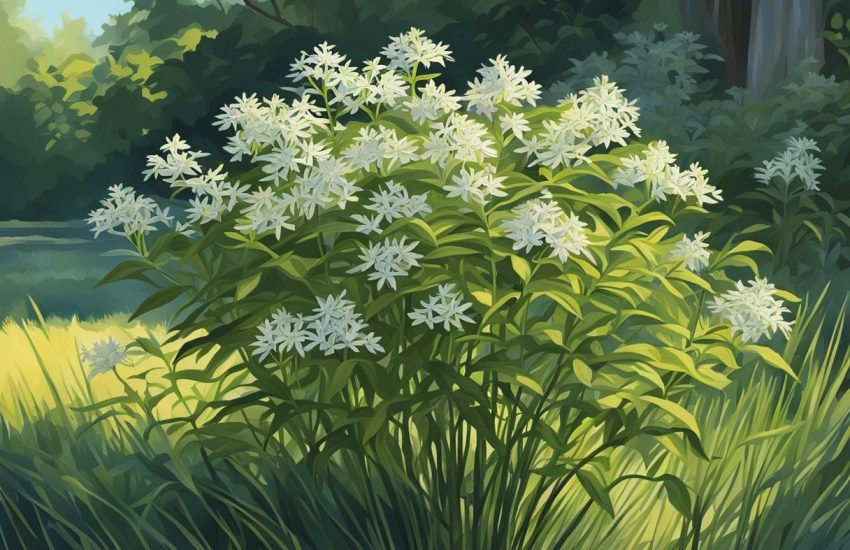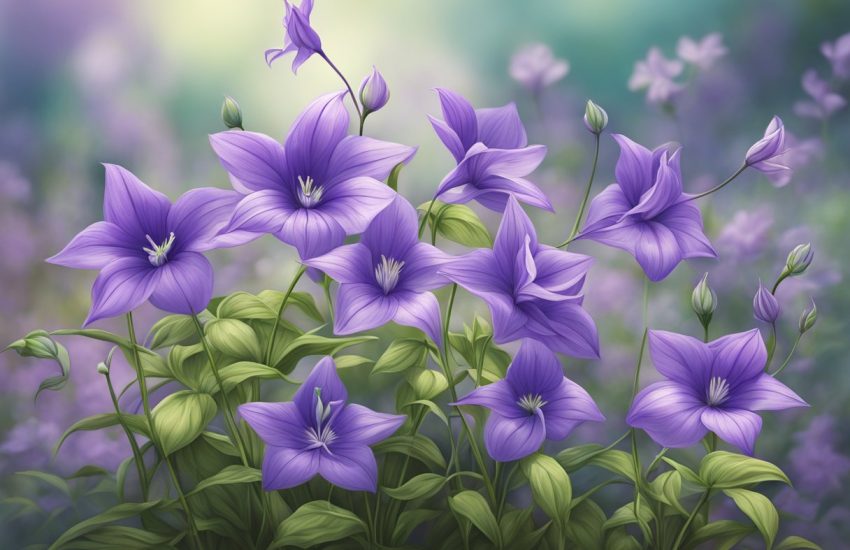Native Florida Hummingbird Plants to Grow in Your Garden
If you live in Florida and you want to attract hummingbirds to your garden, you are probably wondering what plants you should grow. There are lots of great options you can try. Hummingbirds love to feed from a whole variety of different flowers, including things like Crossvine, Tropical Sage, Coralbean, Butterfly Weed, Firebush, Cardinal Flower, and Pitcher Sage. You could also try Lupines, Blue Porterweed, or Spotted Bee Balm. Any of these plants should provide the hummingbirds with a much-needed drink that will help to sustain them. Let’s explore them in more detail!
Crossvine (Bignonia capreolata)
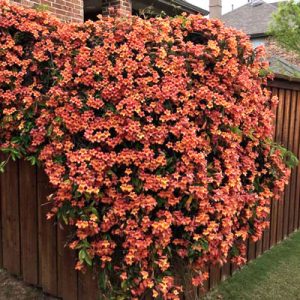
Crossvine is a gorgeous climbing plant that produces stunning 2-inch long flowers in clusters. There are different varieties, but the Tangerine Beauty is a particularly attractive one, with narrow flowers shaped like bells.
Although it’s a climber, it’s a gentle plant that rarely causes much damage to the surface it climbs over, and it can be used to create a lovely screen.
It produces plenty of nectar that will feed the hummingbirds, and the narrow flowers make it difficult for other creatures to get in and steal the sweet liquid, so this is an ideal plant for your garden.
Tropical Sage (Salvia coccinea)
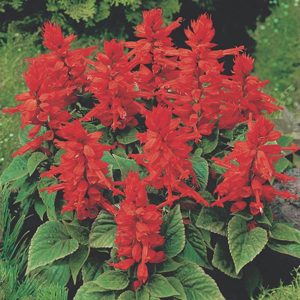
This plant creates vivid, scarlet flowers and can grow to 4 feet tall, making it an impressive garden plant that hummingbirds will love hovering in front of and feeding from. It also feeds butterflies, so it’s a wonderful way to make your garden more nature friendly in general.
It has leaves that are oval or heart-shaped, and long spikes that produce the flowers, which can bloom from the summer right through into the fall.
Coralbean (Erythrina herbacea)
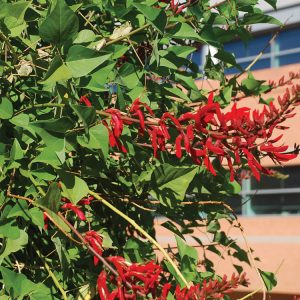
Native to Florida and other eastern States, Coralbean is another option with brilliant red flowers that form long, flat tubes that a hummingbird’s beak can perfectly slot into. These tubes may be as much as 2 inches long, but are usually only about 1/8 inch across, so they are difficult for other nectar-feeders to access.
This makes them ideal for feeding hummingbirds, and you may see several birds feeding at once from just one plant at times. The leaves of the coralbean are compound and have three unique leaflets that bulge in the center.
This plant flowers in late spring and early summer, but by fall, it will start to produce seeds, so it isn’t good for late feeders.
Butterfly Weed (Asclepias tuberosa)
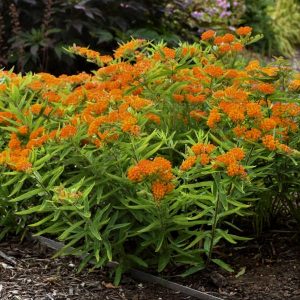
This bushy perennial produces bright whorls of orange flowers in clusters, and it keeps blooming throughout the long summer months, providing hummingbirds with a lasting source of food that they can keep returning to, especially once the plant is established.
It can reach up to 24 inches tall, and has a similar spread – meaning that it can turn a good chunk of your garden into a feeding opportunity for the birds. It’s ideal for planting in a sunny spot, and it’s a hardy plant that doesn’t need much care or attention.
It also feeds other nectar-feeders, hence the name, but hummingbirds will certainly benefit from its sweet offerings and will get plenty of nectar from it. Do note, however, that this plant is toxic to cats and dogs, as well as horses, so don’t plant it if you have pets.
Firebush (Hamelia patens)
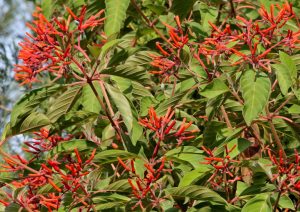
If you are looking for a plant that will flower for a long time, the Firebush is an ideal option, because it blooms from late spring until late fall – and it can keep flowering until the first frost hits. It’s an insect and bird-friendly plant, and even produces berries that other birds will eat. Hummingbirds love to drink the nectar from this showy plant.
Its size varies depending on where it grows, but it can reach as much as 15 feet tall if it is given the right conditions. It’s easy to keep it smaller if you prefer, however, so you don’t need to worry if you only have a limited space for it. Be aware that if you live in North Florida, the plant will die back when the frosts come, but it will regrow when the temperatures warm up again.
The flowers are tubular and very thin, making them perfect for hummingbirds to sip from with limited competition – although some insects can generally reach the nectar as well.
Cardinal Flower (Lobelia cardinalis)
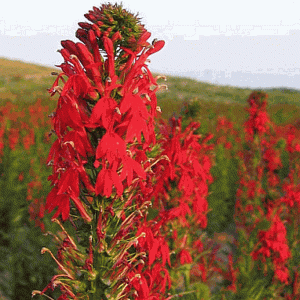
With its rich, scarlet blooms, cardinal flowers look like royalty in the garden, and they will certainly attract some amazing visitors. They produce plenty of nectar to appeal to hummingbirds, and have a long tube with a semi-circle of showy petals fanned out around the bottom. There are three lower petals, and two upper ones, creating a distinctive and unique shape.
The leaves are glossy and bright green, and the flowers rise up on spikes with reddish stems. This striking plant prefers to be kept in wet ground, so it’s perfect if you have a marshy area, and it can flower from summer through to fall.
It should be cut back once it has flowered, but it should come back year after year, and it can reach as much as 6 feet tall.
Pitcher Sage (Salvia spathacea)
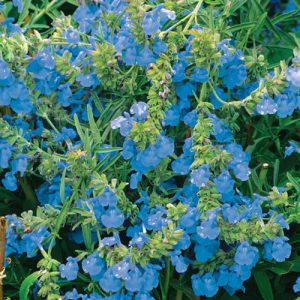
Sometimes referred to as hummingbird sage because it is so popular, pitcher sage blooms from early spring to mid-summer in most cases, which means it is a valuable early source of food for hummingbirds – which could be critical.
Its flowers are dark lilac, and grow on spikes, with lighter pink or purple tubes protruding, which the hummingbird will drink from. It can grow up to 30 inches tall and as much as 5 feet wide.
It is surprisingly cold resilient, which may make it a great option if you are in North Florida. It copes well with open spaces or with shade, making it a flexible plant to add to your garden.
It is also deer tolerant, so it might be a particularly good plant to choose if you are troubled by other wildlife.
Lupines (Lupinus)
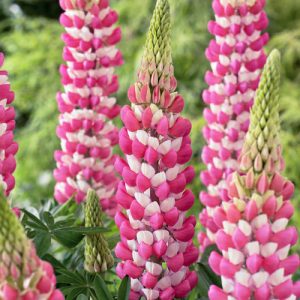
There are a great many varieties of lupines, and hummingbirds love pretty much all of them. These highly attractive flowers can reach around 3 feet tall and 3 feet wide, and they usually bloom from early to mid or late summer. That means they are a shorter-lived food source, but they can still be valuable.
They have beautiful, elegant spikes to hold their flowers aloft, and because hummingbirds are so keen on them, you can pick any variety that you like. This makes it easy to match them to other colors in your garden. You should also be able to find a variety of sizes, so if you have a small garden, you can still grow these.
Blue Porterweed (Stachytarpheta jamaicensis)
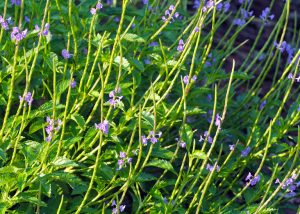
If you are getting tired of all the vivid reds, you might want to try a subtler option, such as Blue Porterweed. This is a low-growing perennial that will have green foliage year round, and it forms trailing stems that hold up flowers in a range of blues and deep purples. Choose a lavender variety, a purple one, or a true blue.
The flowers are tubular and have a very short lifespan, only being open for one day, but they are still an excellent source of food for hummingbirds. Hummingbirds are not as attracted to blue flowers as pink and red flowers, but they will feed on these delicate blooms if they find them.
The foliage is dark green and has serrated leaves on either side of the stems, and this plant is also an excellent source of food for butterflies. Because it is low-growing, it’s easy to include this in a garden that has lots of taller plants, although it does like to get a reasonable amount of sunlight.
Spotted Bee Balm (Monarda punctata)
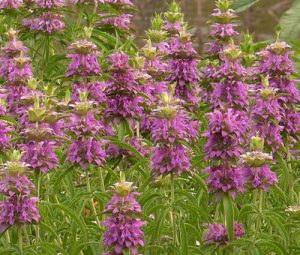
If you like delicate pinks, Spotted Bee Balm is a particularly notable garden specimen with flowers that grow somewhat like pagodas on the top of tall stems. They can be between 2 and 3 inches across, and they bloom in early and mid-summer.
As the name suggests, these are insect-friendly flowers, but with their light pink petals, they will also attract and feed hummingbirds. Their nectar is deep inside a tube, which hummingbirds can insert their long tongues into and sip from while hovering.
The plants can reach between 1 and 2 feet tall, and they will attract a lot of wildlife, as they are generous with their nectar production. Planted in a wildflower meadow or in flowerbed, you’ll soon see how much they are enjoyed by the garden’s visitors.
Trumpet Vine (Campsis radicans)
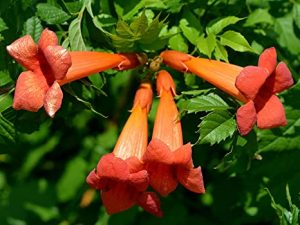
This amazing plant can climb up to 40 feet high if it is given something to scramble over, and it will output blooms between midsummer and early fall. Some people call it the hummingbird vine because its tubular flowers are so beautifully engineered for hummingbirds to feed from. It is also very generous with its nectar, so the birds will get plenty of food from it.
It is one of Florida’s natives, and it will grow superbly with little fuss or care. Indeed, the biggest challenge with Trumpet Vine is usually keeping it under control so that it doesn’t spread over your whole garden. That’s great for your bird visitors!
Columbine (Aquilegia)
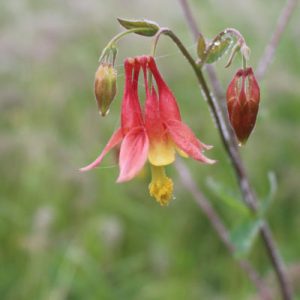
Growing up to 3 feet tall, Columbines can make a fabulously showy display and they are a brilliant source of food for hummingbirds. They come in a whole range of shapes and sizes and colors, so you can pick whatever would look best in your garden, and make the most of the variety by planting several different types.
This plant usually starts blooming in May, which is the time when many hummingbirds first get to Florida – so it’s an ideal option to ensure that they have plenty of nectar to drink straight away. You will probably find that the hummingbirds seek out your Columbine flowers before they go for anything else in the garden.
These plants prefer shady spots, so they can be great for filling in corners that would otherwise be free from color and food for the birds.
Indian Pink (Spigelia marilandica)
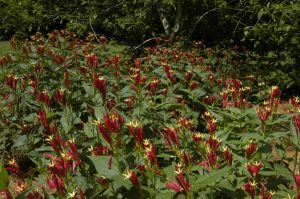
If a plant ever looked like it had been designed for a hummingbird’s beak, it would be the Indian Pink. These have elongated, tube-like flowers with narrow openings that are perfect for these birds to get into, and they are bright red, so they will catch a hummingbird’s eye too, ensuring it finds the food that is on offer.
The center of the flower is bright yellow, meaning that the bird has an easy guide for its beak and tongue, and the plant produces lots of these attractive flowers, so there are plenty to feed on.
It can reach up to 2 feet tall and will bloom in June, so it’s again well-timed for the early feeders to get what they need.
Beard Tongues (Pentsemon)
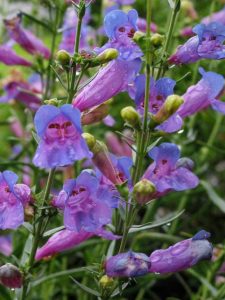
Dressed in striking pink, the Beard Tongue flowers again look like they have been tailor-made for a hummingbird. They often have a darker or lighter outlined center to help guide the bird’s beak, and the flowers grow on long stalks so the bird can easily move between them, feeding on each by turn.
These plants are also known for providing hummingbirds with water, because moisture will collect inside the flowers, as well as nectar. They bloom between April and June, so they should be waiting when the hummingbirds arrive, and they will be a welcome source of food.
There are quite a few different varieties, so find out if any particularly like your local climate before planting them, as this is the best way to ensure that they thrive and produce plenty of nectar for your hummingbirds to enjoy.
Conclusion
Hummingbirds depend heavily on plants to provide them with nectar, and a lot of people are keen to make sure they get what they need by filling their gardens with flowers. The more nectar a flower produces, the more likely it is to be suitable for hummingbirds but remember to look out for plants with elongated flowers that they can drink from with ease.

